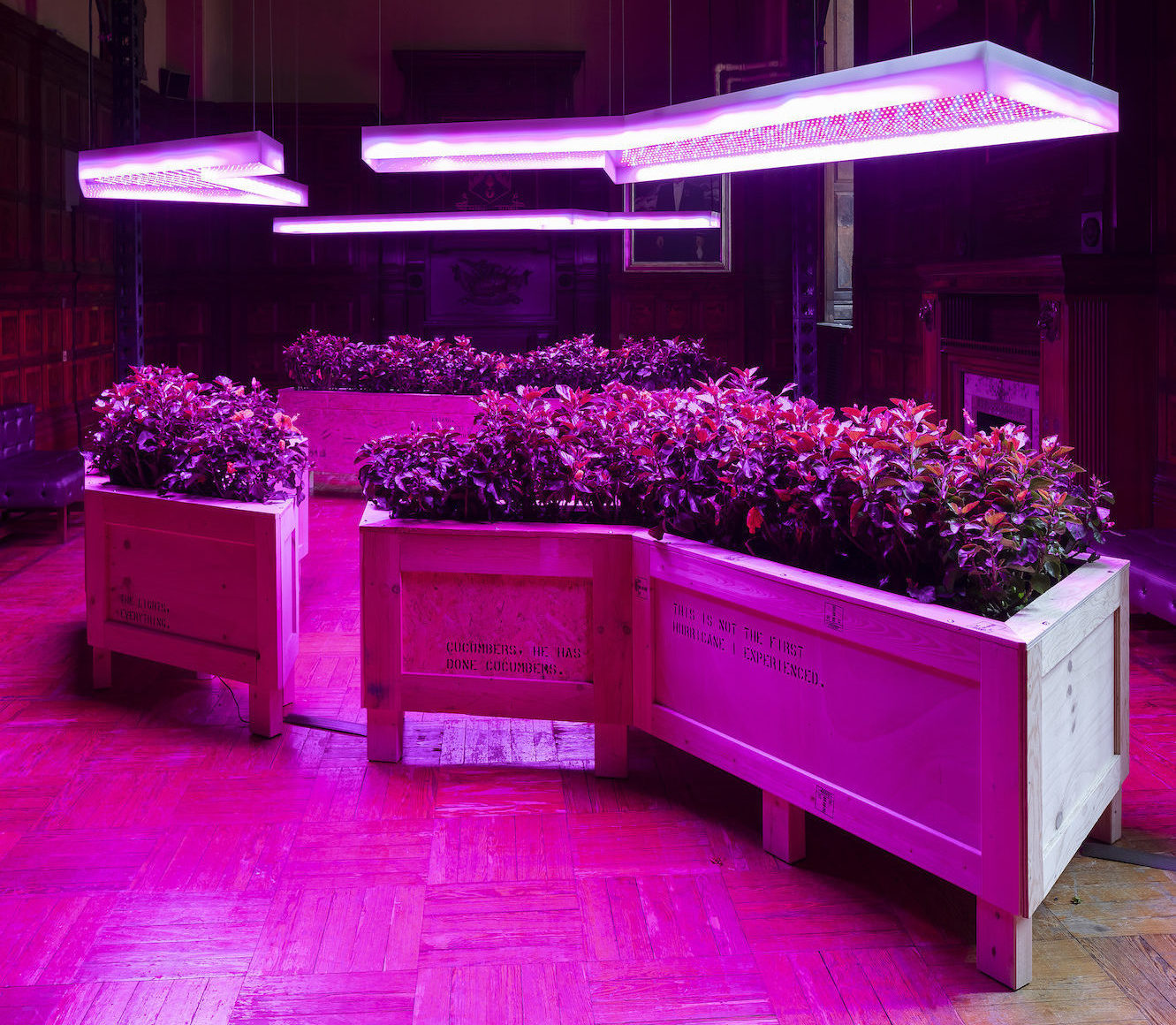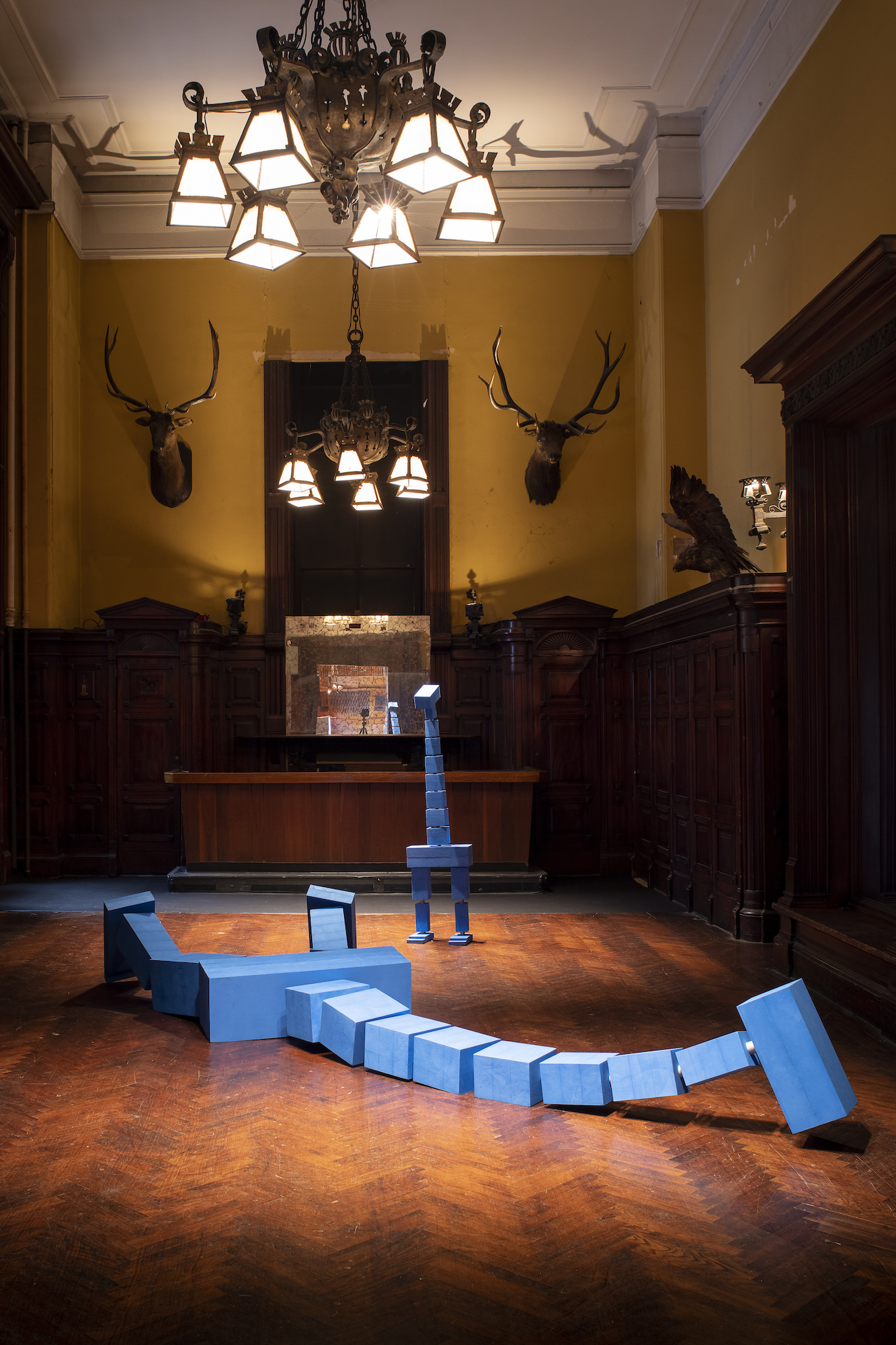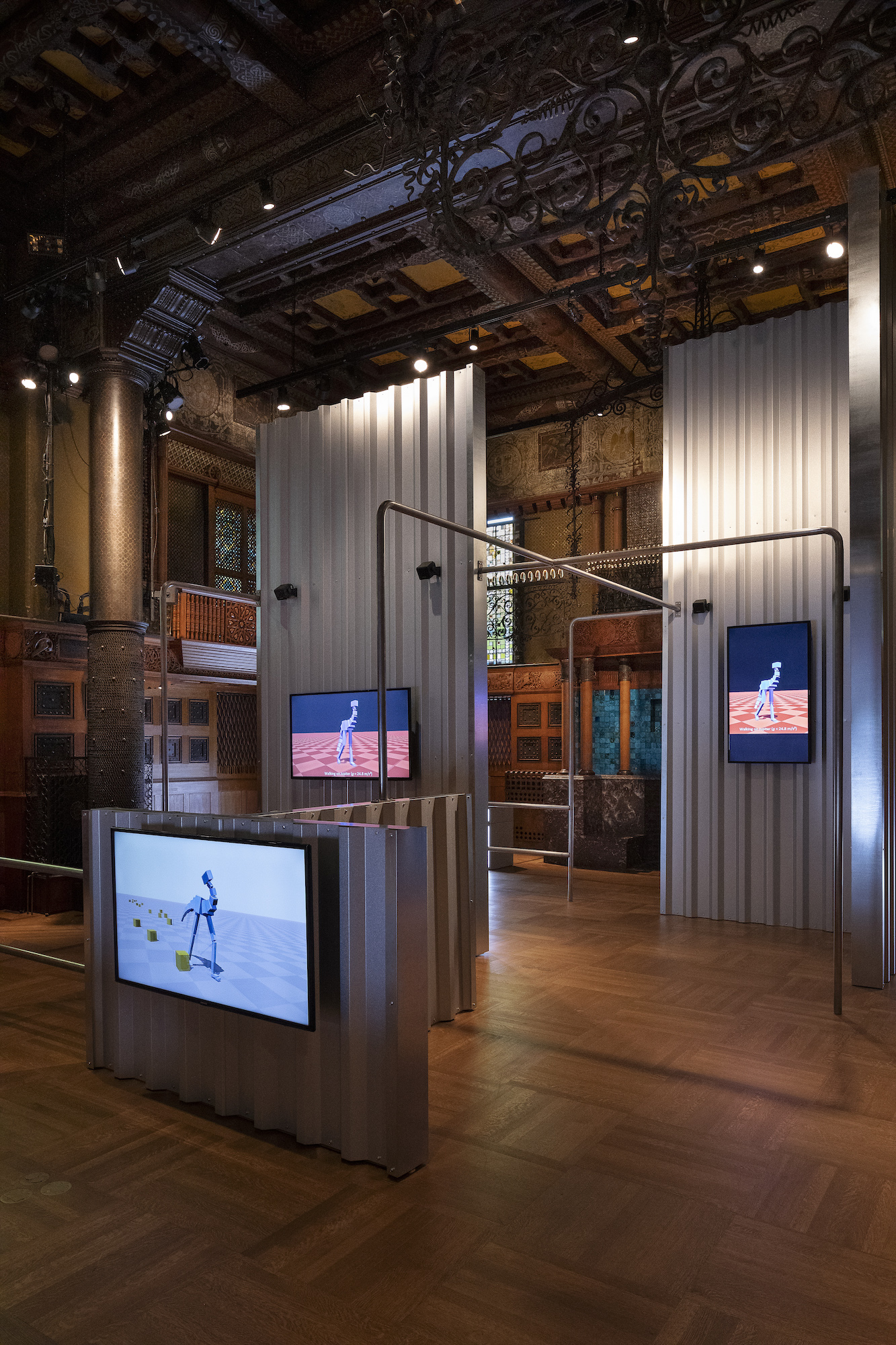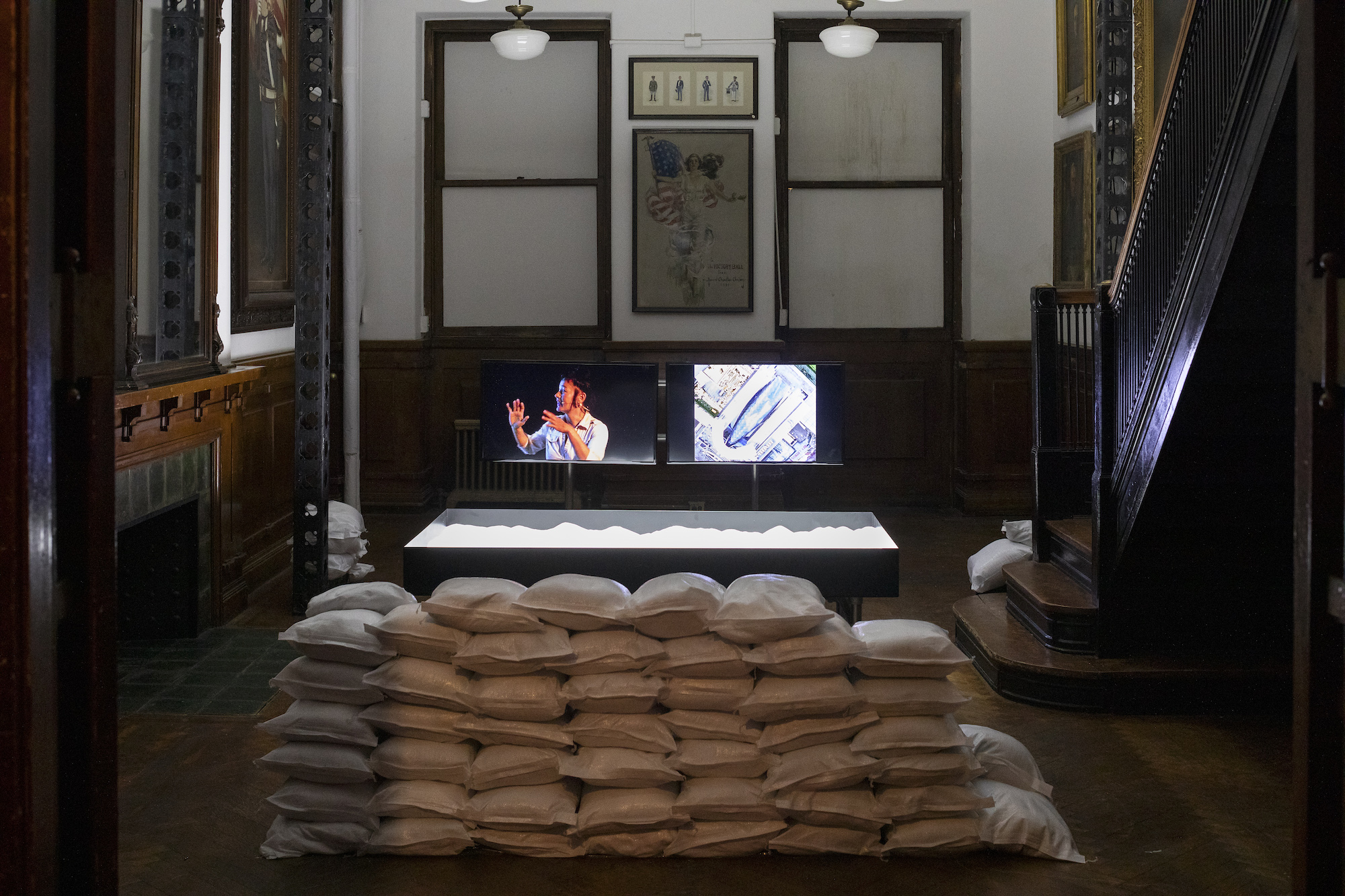This Is America: A Drill at the Park Avenue Armory

Hito Steyerl, “FreePlots,” installation view, 2019 [photo: James Ewing; courtesy of the artist and Park Avenue Armory, New York]
Share:
Gun violence. This phrase describes an unavoidable reality, entrenched as a fact of life in the United States. It’s a peculiar way of saying it: gun violence. As though the violence emanates directly from these inanimate objects—metallic, cold, hard, short, loud, or silent. As if they come to life on their own, wreaking havoc, violently hurling themselves every which way in a cacophonous caricature of biomorphic revolvers, rifles, and .22s all going off in a blazing duel. It is a wag-the-dog phrase that diverts us from the more pressing issue, from the bigger problem around it: not just that “guns don’t kill people, people kill people,” but also that power and its influence infiltrate all aspects of social and political life.
On the Upper East Side of Manhattan—occupying an entire city block since 1880—the Seventh Regiment Armory stands as a fortress and emblem of this side of Manhattan’s upper class. Today it is the arts venue known as the Park Avenue Armory. To put it in perspective, the building is a five-minute walk away from 740 Park Avenue, one of the city’s wealthiest residences and home to the country’s richest and most powerful (it features in Park Avenue: Money, Power and the American Dream, a documentary on the country’s rigged financial gap, as seen along this northbound/southbound boulevard). Online, the Park Avenue Armory boasts its own history through the building’s architecture and patriotic narrative. Designed in a gothic revival style with layers of red brick, the building was constructed and furnished with private funds. The self-proclaimed Silk Stockings or Blue Bloods—New York’s social elite—made up the Seventh Regiment of the New York State Militia. They used the building as their headquarters, equipped with a massive drill hall, and a basement firing range, as well as the prized Louis C. Tiffany–designed Veterans Room, laden with ornamental paneling and stained glass.
Hito Steyerl, “Prototype 1.0 and 1.1,” installation view, 2017 [photo: James Ewing; courtesy of the artist and Park Avenue Armory, New York]
Hito Steyerl, “HellYeahWeFuckDie, Robots Today,” installation view, 2016 [photo: James Ewing; courtesy of the artist and Park Avenue Armory, New York]
Today, the Park Avenue Armory commissions large-scale works of contemporary art by established artists. For her recent exhibition, Drill, artist and theorist Hito Steyerl drew upon the building’s history in using the Drill Hall and the luxurious period rooms to exhibit the eponymously titled commissioned work, as well as smaller past works. Steyerl, whose videos usually embrace the degraded image of the digital realm, chose instead to work in a site-specific way, exploring the entwinement of art and armament. Her monumental three-channel video installation probes an even more monumental social issue—widespread gun violence and its contested legislation in the United States. Steyerl uses the building’s past—as subject and backdrop—to unfold a narrative of violence rooted in the lap of power and connected to the rooms of the Armory that are today conserved and celebrated for their architecture and design.
In Drill’s video, Anna Duensing—a historian and doctoral candidate in Yale’s program of History and African American Studies—gives a tour of the building and discloses that within these very rooms members of the Seventh Regiment founded the National Rifle Association as a way of bringing the men together for target practice. Today, the group has become a national organization for campaigning against gun control laws. Anyone can join the NRA. Membership packages start at $45 a year. New members receive gifts including a camo duffle bag and a rosewood-handled pocketknife, as well as magazine subscriptions to Shooting Illustrated, American Rifleman, or America’s 1st Freedom. It seems like a far cry from the association’s initial aspirations for an exclusive, genteel shooting club. Other protagonists of Drill include survivors of gun violence, students, and activists; Nurah Abdulhaqq, co-founder of National Die-In (her cousin died from gun violence); Abbey Clements, activist and survivor of the Sandy Hook shootings; and Kareem Nelson, founder of Wheelchairs Against Guns. Steyerl intercuts footage of interviews and recent gun legislation protests with sequences of the Yale Precision Marching Band sweeping through the Drill Hall. The ensemble plays a score consisting of algorithms from data on mass shootings across the US. In this dramatic staging, strips of light illuminate a pattern under the large projection screens. At first the light tape appears to be the outline of a floor plan, somewhat like that of the citadel itself. But as the video proceeds and the narrative materializes, the ground lights become more like demarcations, a regime of utility for a march, waltz, or demonstration. This zigzagging from military march to graceful waltz is a potent entanglement that materializes as Steyerl’s video paints a picture of upper-class decadence: the guests at grand balls once spun around the Drill Hall as the men plotted the foundations of America’s gun liberalism in their lavish veteran rooms. The light tape becomes like a portal to view these various scenarios within this cavernous, darkened hall.
Hito Steyerl, “Duty Free Art, Is the Museum a Battlefield?,” installation view, 2013, 2015 [photo: James Ewing; courtesy of the artist and Park Avenue Armory, New York]
Facilitating the movement of viewers who can observe the three screens from different points on the floor, Drill’s installation is conceived like social architecture that beams: this is America! A dramatic soundtrack reaches its dizzying climax as the moment of reckoning arrives: gun violence survivors face the luxurious halls of the Armory—a moment of retribution as the present confronts the past. It is an uneasy climax as the realization of power’s potential for affect sets in. There is something uncanny about power’s ability to publicly air its own self-retribution via contemporary art that is concerned with social justice. I cannot help but be perplexed by this gesture, a demonstration of the present-day Armory’s liberalism by way of its willingness to self-critique—a sort of slap on the wrist, which is abundant among institutions with such histories of power and militarism. I wonder if Steyerl might have come to this view as well. Drill is a work of institutional critique that mines these histories and points out that “History is the art of highlighting whatever is hiding in plain sight,” as though Steyerl is performing history at that moment: pulling forth seemingly disparate moments in time to confront this unfolding narrative.
Steyerl’s artistic practice is invested in the circulation, meaning, and abundance of images, and here she grapples with a social disaster whose image is withdrawn from the mainstream. School shootings, church shootings, and recordings of these decisive moments are not easily seen. In the space of an entire city block, the artist has elected to use the financial costs of her Armory commission to amplify the voices of those who continue the fight for justice—for example, by casting Duensing, a scholar whose undergraduate history seminars include Confronting Jim Crow in the Age of Fascism. With Drill Steyerl uses the context of the Armory to continue the conversation on gun violence. With her cultural power as an artist, she draws viewers into her narrative and privilege to exhibit at a site for the display of wealth and influence: not so much as a reveal, but perhaps as more of an underscoring of how art can be implicated in—and respond to rather than withdraw from—mechanisms of violence.
Fawz Kabra is a curator and writer living in Brooklyn, New York. She has organized exhibitions at the Center for Curatorial Studies, Bard College, New York; the Palestinian Museum, Birzeit; BRIC House, Brooklyn; and Art Dubai. She was Assistant Curator, Solomon R. Guggenheim Foundation, Abu Dhabi Project, New York; Manager of Public Programs, Cultural Department, TDIC, Abu Dhabi; and symposia organizer, including School is a Factory? at Global Art Forum 13, Dubai. Fawz edited the publication No to the Invasion: Breakdowns and Side Effects (CCS / Barjeel / RAM 2017). Fawz’s writing and interviews appear in various art publications, including Art Papers, Canvas, Ibraaz, and Ocula. She has participated in panels and presented talks at the CCS; Asia Contemporary Art Week, New York; and Power Talks, Toronto. She has been a visiting critic at The New School, Parsons; and Transart Institute, New York.


